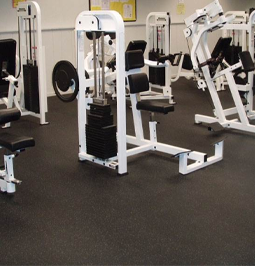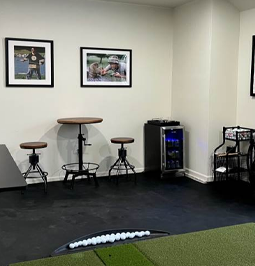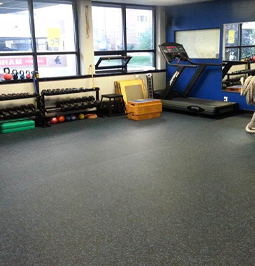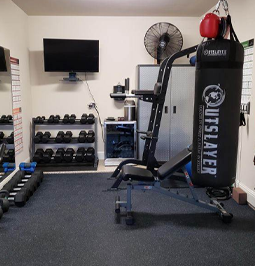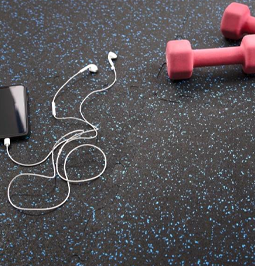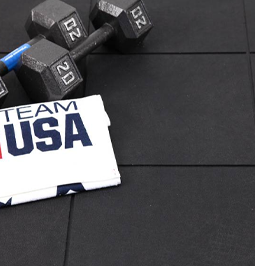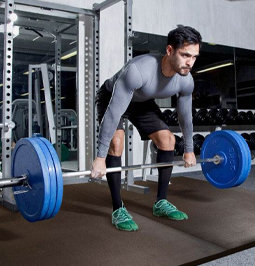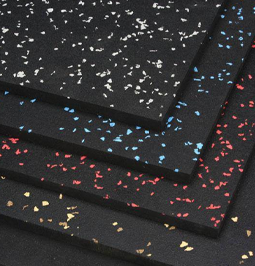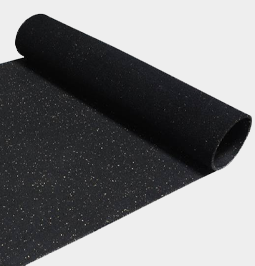Commercial Gym Flooring: Everything Rubber
There’s no better feeling than opening the fitness studio you’ve dreamed of or finishing a much-needed gym remodel. An essential part of your project is choosing versatile commercial gym flooring to protect your athletes’ joints and your subfloor from rigorous routines.
We’ve got a variety of commercial fitness flooring, including rubber rolls, rubber tiles, and rubber mats. Explore the pros and cons of each, thickness and installation options, and our top recommendations.
We’ve got a variety of commercial fitness flooring, including rubber rolls, rubber tiles, and rubber mats. Explore the pros and cons of each, thickness and installation options, and our top recommendations.
About Commercial Gym Rubber Flooring
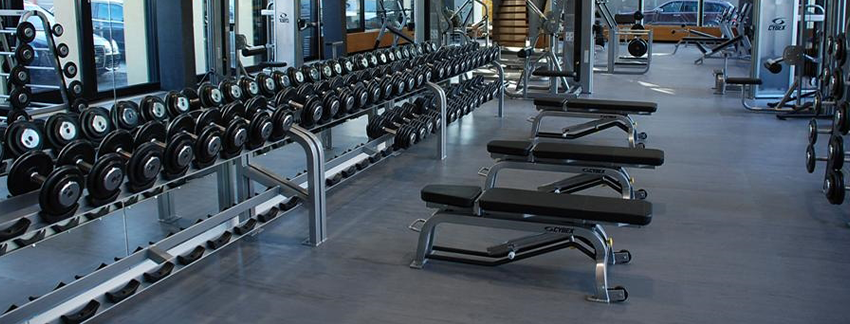
This is the most common choice in commercial fitness centers. Fitness enthusiasts and gym owners alike love it for the variety of sizes and thicknesses, water resistance, extreme durability, and slip-resistant surface underfoot.
Rubber workout flooring comes in rolls, tiles, and mats – great for different workout intensities, install needs, and budgets.
Commercial Rubber Flooring Thicknesses
Regardless of the type of rubber flooring you choose, it’s essential to get the correct thickness for your intended use. If you choose material that’s too thin for your fitness needs, the lifetime of your floor may be shorter.Recommended Thicknesses
- 8mm: The bare minimum we recommend for a commercial setting.
- 3/8": Our most popular choice for commercial gyms.
- 1/2”- 3/4”: Ultra-thick rubber flooring to protect your subfloor from the impact of your heaviest dumbbells.
- 1” +: Olympic-rated flooring for heavy lifting that can withstand dropped weights.
How to Install Commercial Gym Rubber Flooring
Explore the most popular installation options.- Loose-lay: Rubber is naturally heavy enough to stay in place with no additional adhesive. If you loose lay your rubber rolls or tiles, you can pick
- Double-sided tape: For a more secure install, consider using double-sided carpet tape around the perimeter of your rubber floor. If needed, you can remove your floor and transport it to another location.
- Glue-down: In extreme conditions, CrossFit® and commercial gym owners prefer to glue down their rubber gym flooring to ensure no movement or curling up at the edges of the floor. As it’s a permanent solution, once you glue down your rolls, you can not reuse them elsewhere. Note: Recommended for rubber rolls only, as a seamless installation with rubber tiles is challenging. Also, once you glue down your rolls, you can not reuse them elsewhere.
Commercial Gym Rubber Flooring Rolls
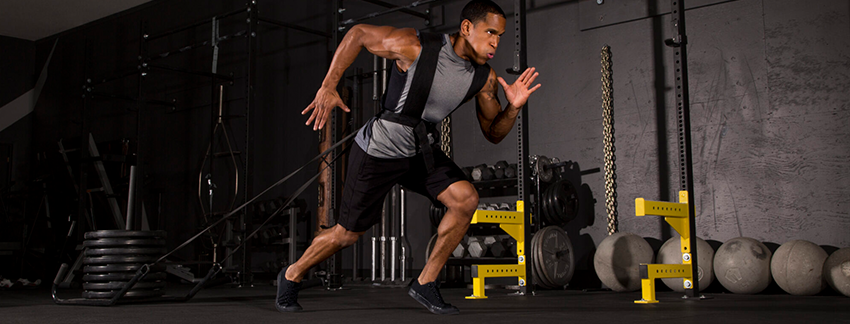
Rubber rolls are a staple in just about every traditional gym out there. They’re the premier commercial gym flooring for sharp, sleek looks, extreme durability, and shock absorption. We offer various thicknesses for different workout needs, including high-impact, plyometric movements.
Pros of Rubber Flooring Rolls
- Ultra-durable: Thick rubber material in commercial gyms can last for years.
- Simple installation in large spaces: Easily cover a large surface area with a couple of rubber rolls.
- Easy to clean material: Simply vacuum or use a damp mop when necessary.
- Environmentally responsible: Many of our rubber flooring rolls are made from recycled rubber manufactured in the USA.
- Virtually seamless appearance: When rolls are correctly aligned, the seams of the floor are almost undetectable. The seamless appearance helps provide an extremely polished look.
- Sound and shock absorbing: Rubber rolls absorb shock underfoot and sound from dropped heavyweights and equipment – perfect for high-traffic commercial gyms.
- Anti-microbial: Rubber material is water-resistant and won’t trap bacteria in your rubber floors or beneath.
Cons of Rubber Flooring Rolls
- Weight: Rubber flooring rolls have substantial weight, so if installing on your own, you may need additional help.
Commercial Gym Rubber Floor Tiles
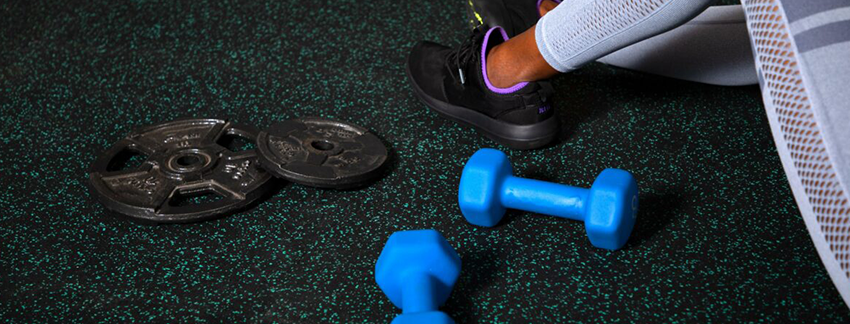
Rubber tiles are durable, affordable, and known for their easy, DIY, interlocking installation. Although they’re most well known as the premier home gym flooring solution, many gym owners love using rubber tiles as commercial gym flooring.
Pros of Rubber Tiles
- Easy DIY installation: The most significant appeal for tiles over rolls is that they come together just like puzzle pieces, which you can loose lay without adhesives.
- Lighter than rubber rolls: You can quickly move your tiles piece by piece.
- Environmentally responsible: We offer a wide variety of rubber floor tiles made from recycled rubber and manufactured here in the USA.
- Sound and shock absorbing: For tough workouts and heavy weights, tiles will absorb the shock and sound, keeping your joints and subfloor safe and sound.
- Simple replacement: If you damage one of your tiles, you can replace it with a new one instead of the whole floor.
Cons of Rubber Tiles
- Tedious installation for large spaces: Although rubber gym tiles are easy to install, they get time-consuming in large spaces. They are best for smaller areas.
- Seams: The gaps between the seams of rubber tiles can allow liquids through to the subfloor. Additionally, rubber tiles provide a slightly less seamless appearance than rubber rolls.
- Price: Tiles tend to be more expensive than rolls per square foot.
Commercial Gym Rubber Floor Mats
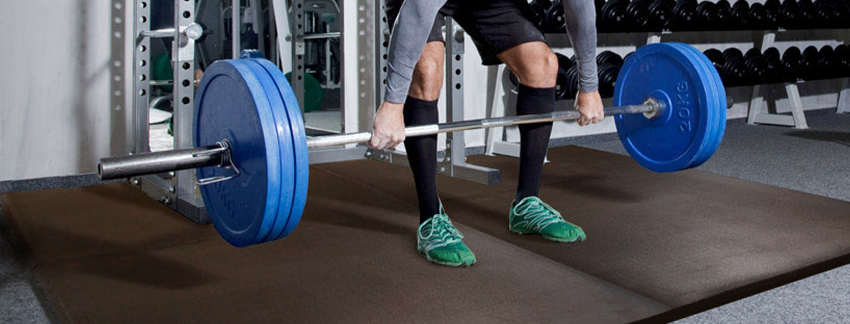
Rubber gym mats are a fantastic solution for small spaces or dedicated weight rooms. You can choose from thin 1/4" Tough Mats for bodyweight exercises up to 3/4” Shock Mats, which handle the impact of heavy Olympic weightlifting and dumbbell exercises.
Installation is simple, too. Lay the rubber mat down where you want, and you’re done. In extreme conditions, use double-sided carpet tape around the perimeter of your mat to ensure it stays perfectly in place.
Pros of Rubber Floor Mats
- Great for small spaces: When you don’t need to cover an entire area, rubber weight mats will be your best option, saving you time and money.
- Traction and shock absorption: Rubber mats provide the necessary traction and comfort your athletes look for. Rubber’s naturally shock-absorbent material reduces the impact on their bones and muscles during cardio, weight lifting, and more.
- Noise reduction: Rubber gym mats dampen the vibrations that come from vigorous exercise, also helping to protect the shock to your subfloor.
- Portable: No installation is necessary with gym floor mats. You can easily change your setup by simply picking the mats up and moving them.
Cons of Rubber Floor Mats
- Not appropriate for large spaces: We recommend rubber rolls to save money and installation time if you have a large area to cover.
- Price: Rubber gym floor mats are affordable on their own, but they are more expensive per square foot.
Top Recommendations
Commercial Gym Flooring FAQ
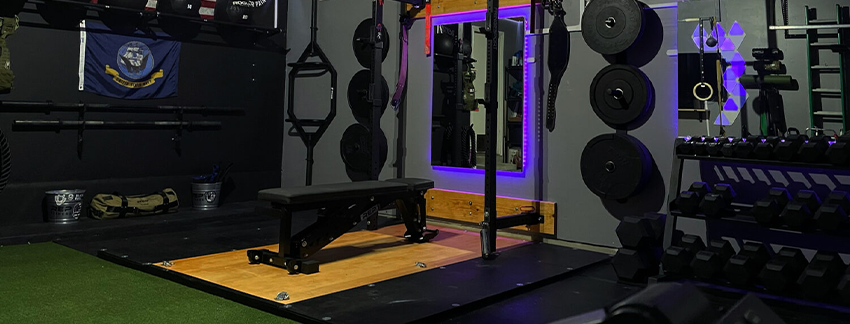
Here are our most frequently asked questions and answers about commercial gym flooring.
What’s the best flooring for commercial gyms?
Rubber flooring and gym turf are the best options for a commercial gym setting. They’re highly durable, shock-resistant, and provide a stable, even surface for safer workouts.Most gyms have both throughout the space to offer a unique feel and experience for different exercises.
How thick should commercial rubber gym flooring be?
There is a common misconception that commercial gyms require the thickest rubber gym flooring possible. Most commercial and even CrossFit® gyms do well with the 3/8” rubber.For dumbbell areas of the gym, most commercial gyms owners chose 1” + rubber gym tiles. As the impact of dropped weights decreases the floor’s support over time, you can easily replace your rubber tiles when needed without removing your entire floor. Note: Replacing your rubber tiles will be more challenging if you glue them down
How do you clean commercial gym flooring?
Rubber Flooring Cleaning Tips
Each product offers specific instructions on cleaning and maintenance. For most commercial gym flooring options, you can sweep regularly and occasionally damp mop with a simple cleaning solution of mild soap and water.How can I protect my subfloor in a commercial gym setting?
For maximum shock absorption, we recommend selecting our most thick rubber and gym turf flooring. If you’re highly concerned about your subfloor, our variety of underlayments can provide peace of mind and create that extra barrier between your main floor.Are there eco-friendly commercial gym flooring options?
Yes, there is eco-friendly commercial gym flooring. We offer a variety of recycled-rubber flooring made from commercial truck/car tires.Do I need professionals to install my commercial gym flooring?
You can install your commercial gym flooring yourself; however, having a professional install can ensure precision and long-lasting results. We recommend considering your project timeline, the size of your space, and your budget before deciding.Conclusion
Create the commercial gym you feel inspired by with ultra-durable and attractive gym flooring! Shop our full selection of rubber options today!


